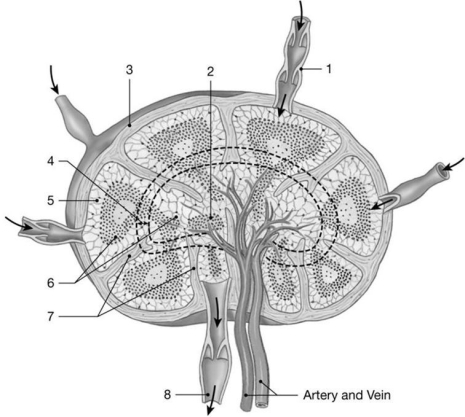A) Immunity
B) Memory
C) Adaptation
D) Tolerance
E) Versatility
Correct Answer

verified
Correct Answer
verified
Multiple Choice
The medulla of a lymph node contains ________ lymphocytes and macrophages.
A) cytotoxic T
B) medullary
C) NK
D) B
E) cordal
Correct Answer

verified
Correct Answer
verified
Multiple Choice
Antigens that trigger allergic reactions are called
A) interferons.
B) microbes.
C) pyrogens.
D) allergens.
E) agglutinins.
Correct Answer

verified
Correct Answer
verified
Multiple Choice
Immunoglobulins, formed of five subunits, that are the first antibodies to be produced in response to infection, are
A) IgA.
B) IgD.
C) IgE.
D) IgG.
E) IgM.
Correct Answer

verified
Correct Answer
verified
Multiple Choice
In general, lymphocytes
A) spend most of their time in lymphatic tissue.
B) have relatively short life spans.
C) have two nuclei.
D) are produced and mature only in red bone marrow.
E) are located primarily in the blood stream.
Correct Answer

verified
Correct Answer
verified
Multiple Choice
Infection with the HIV virus occurs through
A) eating contaminated food.
B) airborne droplets from coughs and sneezes.
C) intimate contact with an infected person's body fluids.
D) casual contact with an infected individual.
E) sharing clothes with an infected individual.
Correct Answer

verified
Correct Answer
verified
Multiple Choice
When an antigen is bound to a Class II MHC protein, it can activate a ________ cell.
A) plasma
B) helper T
C) NK
D) suppressor T
E) cytotoxic T
Correct Answer

verified
Correct Answer
verified
Multiple Choice
The primary function of the lymphatic system is
A) the transport of hormones.
B) circulation of nutrients and dissolved gases.
C) defending the body against both external and internal threats.
D) the production and distribution of plasma proteins.
E) the production and maturation of leukocytes.
Correct Answer

verified
Correct Answer
verified
Multiple Choice
When antigens bind to inactive B cells and are brought into the cell by endocytosis to be displayed ontheClass II MHC proteins this results in ________ of the B cells.
A) activation
B) sensitization
C) co-stimulation
D) cloning
E) division
Correct Answer

verified
Correct Answer
verified
Multiple Choice
In IgG, the antigen binding site is formed by the
A) variable segment of the light chain.
B) variable segment of the heavy chain.
C) constant segment of the heavy chain.
D) variable segments of both the light and heavy chains.
E) ionized segment of the light chain and the isotropic segment of the heavy chain.
Correct Answer

verified
Correct Answer
verified
Multiple Choice
Immunoglobulins that attach to and sensitize mast cells and basophils are
A) IgA.
B) IgD.
C) IgE.
D) IgG.
E) IgM.
Correct Answer

verified
Correct Answer
verified
Multiple Choice
CD8 markers are to ________ T cells as CD4 markers are to ________ T cells.
A) suppressor; cytoxic
B) cytoxic; helper
C) helper; suppressor
D) NK; cytoxic
E) plasma; NK
Correct Answer

verified
Correct Answer
verified
Multiple Choice
Figure 22-1 The Structure of a Lymph Node
 Use Figure 22-1 to answer the following questions:
-Identify the dominant cell type in the area labeled "6."
Use Figure 22-1 to answer the following questions:
-Identify the dominant cell type in the area labeled "6."
A) T cells
B) B cells
C) erythrocytes
D) platelets
E) dendritic
Correct Answer

verified
Correct Answer
verified
Multiple Choice
A sample of John's blood shows a high level of pyrogens. This would indicate that John
A) is feeling achy.
B) is producing T lymphocytes.
C) has a sore throat.
D) is running a fever.
E) has swollen lymph nodes.
Correct Answer

verified
Correct Answer
verified
Multiple Choice
Cytokines that make a cell and its neighbors resistant to virus infection are called
A) complement.
B) interferons.
C) interleukins.
D) immunoglobulins.
E) transferrins.
Correct Answer

verified
Correct Answer
verified
Multiple Choice
Frank was bitten by a rattlesnake and received anti-venom containing neutralizing antibodies. Frank received ________ immunity and he ________ long-term immunity as a result.
A) naturally acquired passive immunity; will have
B) artificially acquired passive immunity; will not have
C) artificially acquired passive immunity; will have
D) naturally acquired active immunity; will have
E) naturally acquired active immunity; will not have
Correct Answer

verified
Correct Answer
verified
Multiple Choice
The term lymphadenopathy refers to
A) a congenital lack or malformation of lymph nodes.
B) a chronic or excessive enlargement of lymph nodes.
C) accumulations of lymph in the tissue space.
D) the lack of lymphocytes in peripheral circulation.
E) increased numbers of circulating lymphocytes.
Correct Answer

verified
Correct Answer
verified
Multiple Choice
Stress can affect the immune response in all of the following ways except by
A) inhibiting glucocorticoid release.
B) depressing the inflammatory response.
C) reducing the number of phagocytes.
D) inhibiting interleukin secretion.
E) increasing the level of cortisol.
Correct Answer

verified
Correct Answer
verified
Multiple Choice
Hormones that slow tumor growth are called
A) transferrins.
B) tumor necrosis factors.
C) interferons.
D) radiation agents.
E) chemotherapins.
Correct Answer

verified
Correct Answer
verified
Multiple Choice
A T cell can only become activated after being physically or chemically stimulated by the abnormal targetcell in a process called
A) costimulation.
B) opsonization.
C) sensitization.
D) neutralization.
E) precipitation.
Correct Answer

verified
Correct Answer
verified
Showing 121 - 140 of 167
Related Exams